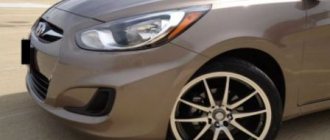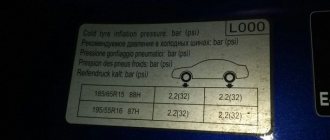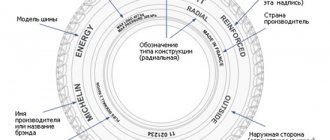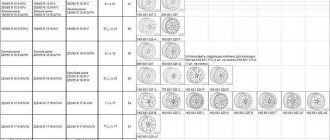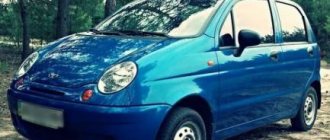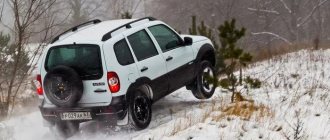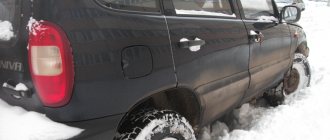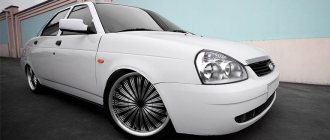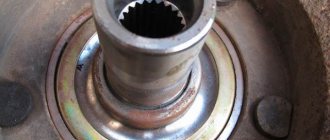One of the elements of the VAZ 2107 that ensures safe driving is car tires. The condition of the wheels is determined not only by their appearance (tread depth, balancing, surface integrity), but also by the air pressure in them. Compliance of this parameter with the standard allows you to extend the service life of not only tires, but also other elements of the car.
- Why is it important to check your tire pressure?
- Tread wear due to incorrect pressure
At low pressure
- For high blood pressure
- Video: tire pressure recommendations
- Seasonal change in tire pressure
Tire pressure in summer
- Tire pressure in winter
Video: how to check tire pressure
What pressure should be in the wheels of a VAZ 2107
The domestically produced car VAZ 2107 is a widely represented model that is in great demand in the CIS countries.
Optimal driving characteristics are complemented by minimal cost, captivating car enthusiasts. The car is equipped with R13 wheels from the factory. Some users replace the “original” disks and install a modern version with a radius of R14. At the same time, they forget that the recommended tire pressure for the VAZ 2107 is relevant only for the conveyor version.
Tuning rollers differ in the size of the cylinder - this forces consumers to blow more air into low-profile structures. Most accurately, the effect of reducing capacity can be seen in the table.
Front pressure Axis
Rear pressure Axis
The norm is considered when the nominal value deviates by no more than 0.1 At.
An additional role of pumping balance is played by the specific weight distribution of the car. Most of the weight when fully loaded is taken by the rear pair. Thus, this bridge requires increased oxygen supply.
Separately, vehicles operated as a “drawn horse” are distinguished. The factory norm is increased according to the increase in load.
The degree of tire inflation in the cold season
How to calculate the degree of tire inflation in winter, based on the manufacturer’s official data. Of course, it is better to use the official recommendations of the car manufacturer or service, but you can be guided by general theoretical knowledge.
The general theory is related to the physics of gaseous media. What does it mean? As the temperature drops, the degree of inflation also decreases, so to improve cross-country ability it is necessary to inflate the tread. You can adhere to the following recommendations:
- when the temperature decreases, to maintain or improve the tire's cross-country ability, the tire should be 0.1-0.2 units more;
- if you need to maintain controllability in icy conditions, the parameters remain the same as in the summer, to a lesser extent this applies to the R16;
- if the weight distribution is the same, the products are inflated equally, while at maximum load the rear group is inflated by 0.2;
- in R14 tires the pressure is within 2.0 bar, in other sizes, respectively, less or more (R16);
- You can pump up the wheels that are driving more.
Tire pressure measurement
You can determine how correctly you select the parameters in winter after passing time on the tread. With normal inflation parameters the tread will have minimal damage. You can see the picture above.
Source
What tire sizes does the manufacturer recommend to install?
Tires for a car are a kind of “part” that is available in a large assortment, so when choosing, some difficulties may arise. Taking into account the manufacturer’s recommendations when choosing one option or another is an opportunity to avoid difficulties and obtain the appropriate ease of use.
The VAZ 2107 car is a multifunctional vehicle that is suitable for country trips, for driving around the city, for transporting large luggage (within the capabilities of a passenger car), and so on. And therefore, tires must be as strong, reliable and wear-resistant as possible to prevent inconvenience and danger.
According to manufacturers, the best option is considered to be 175/70R13 82T tires, since the ratio of the width of the tire profile to its height is an opportunity to get comfortable driving without disturbing the balance of the car.
The key feature of VAZ 2107 cars is that only 13 radius is ideal here, that is, the standard option that presents the car from its best side in terms of decorative and technical design. R14 and R15 are already non-standard sizes, so they slightly change the axis of the car, raising the body and “opening” the clearance between the bumper and the road surface.
Dimensions, weight, load capacity
The vehicle has characteristics such as length, width, height. These indicators help the driver assess how much space the car occupies on the road. Length is the distance between the maximum protruding parts in front and behind. The width is determined by the boundaries of the side mirrors. Height is measured from the surface on which the vehicle is located to the highest point on the roof of the vehicle.
All this data is not difficult to find in the vehicle operating manual. Dimensions Niva 2131:
- length – 4240 mm;
- width – 1814 mm;
- height – 1640 mm.
dimensions
For Niva 2131, the outer minimum turning radius along the axis of the front wheel track is 6.45 m. Equally important indicators are weight (curb weight) and load capacity. The first is the total mass of a set of standard equipment, all necessary consumables (including engine oil, fuel, etc.), as well as the weight of the driver. Baggage and passengers are not included. The 5-door Lada Niva 4x4 weighs 1370 kg.
How is tire pressure measured?
On the territory of Russia, the Atmosphere (1 atm. = 1 kgf/cm²) is accepted as the unit of measurement of air pressure in tires. In the manufacturers' tables, the Atmosphere, due to its close value, is often equated to another unit - Bar (1 bar = 0.98 atm). American automakers indicate values in PSI (1 psi = 1 pound/square inch or pound/square inch). When marking car tires, manufacturers use Kilopascal (1 kPa = 6.895 psi) to indicate the maximum permissible pressure (MAX PRESSURE). Conversion of units of measurement is carried out using the formulas:
- 1 psi = 0.068 atm
- 1 atm = 14.696 psi
- 1 atm = 101.348 kPa
- 1 bar = 0.98 atm
Important! Normal tire pressure does not depend on the brand of tires, but on the brand of your car and the recommendations of its manufacturer.
| Technical atmosphere (at or at) = kgf/cm 2 | (BAR), bar | (PSI) Pound-force per square inch | (ATM), physical atmosphere | kPa (kPa), kiloPascal | |
| Technical atmosphere (at or at) = kgf/cm2 | — | 0,980665 | 14,223 | 0,96784 | 98,066 |
| (BAR), bar | 1,0197 | — | 14,504 | 0,98692 | 100 |
| (PSI) Pound-force per square inch | 0,070307 | 0,068948 | — | 0,068046 | 6,894745 |
| (ATM), physical atmosphere | 1,033 | 1,01325 | 14,696 | — | 101,348 |
Cardan lubrication Niva VAZ 21213, 21214, 2131 Lada 4×4
| How often should the driveshaft be lubricated?—According to the regulations, the driveshaft needs to be lubricated every 10 thousand km. How to lubricate the cardan? - Spline connection of the front driveshaft - with Fiol-1, CV joints-4 grease (or imp. analogues) Bearings of cardan joint crosspieces - with Fiol-2U grease, No. 158 (or imp. analogues) (see also Liquids used and filling volumes) We lubricate the spline joint of the sliding yoke of the propeller shaft by pumping grease with a syringe through a grease nipple until the grease comes out from under the seal. |
Using a syringe with a narrow tip, lubricate the universal joint bearings through a grease nipple until the grease comes out from under all the seals. |
If there is no narrow tip, we syringe the cardan joint bearings on the dismantled cardan shaft (see here). |
On some vehicles manufactured since 2009 (with reinforced spline joints), to replenish or replace lubricant in the spline joint, disassembling the driveshaft is required in the following order.
1. Remove the driveshaft (see here)
2. Mark the relative positions of the shaft parts.
3. Slide the yoke out of the splined end of the shaft.
4. Apply lubricant to the shaft and fork splines.
5. Assemble the shaft taking into account the marks made during disassembly.
6. Install the shaft in reverse order.
How to measure blood pressure
In cars such as the VAZ 2107 or VAZ 2114, of course, there are no automatic monitoring systems already installed at the factory. Therefore, the driver must take care of himself.
Gas pressure gauge for measuring tire pressure
There are several types of devices that allow you to monitor tire pressure. They have different capabilities, which accordingly affects the cost and ease of use.
- For those who infinitely value their lives and safety for them - this is not just a word, there are special tire pressure monitoring systems. Their installation is not easy and the cost is high, but there are a lot of positive qualities. They allow you not only to perfectly inflate your tires, but also to monitor any changes in pressure, which makes it possible to promptly eliminate all shortcomings and problems.
- Various types of pressure gauges: mechanical, electronic, should always be in the arsenal of any driver. Each type has its pros and cons, as well as a significant difference in cost.
- The most primitive devices are cap devices. They don't show exact numbers, but their color scale will indicate whether the tire pressure is normal or not.
Each driver in his lifetime manages to try all types of devices and chooses the most convenient model. Do not forget about the accuracy of the device, not all of them differ in it, as well as the specifics of use.
For a long time to come, VAZs will drive along our roads, deftly maneuvering between proud foreign cars. Indeed, despite the lack of advanced options in most models, they have proven themselves well. And, if their drivers also pay close attention to the pressure in the tires of VAZ cars, then driving safety will be higher.
The device on the Niva failed - the reason
For most classic versions, problems exist.
- The corresponding fuse has blown. This is usually insert F2.
- There are problems with the wiring. Such problems are not uncommon in classic car models. Here you should check the wires for damage to the insulation, loosening, oxidation of contact groups, breaks.
- Damage to the device. Here you should check the device circuit for breakdowns and burns.
If we are talking about modern modifications with an ECU, it is easier to find the problem using computer diagnostics. The BC standard errors will accurately indicate the location of the fault.
Niva instrument panel does not light up
The backlight of the shield is checked in the same way. If the panel periodically blinks or only some of the indicators go off, check the wiring. This is where the contact groups are usually oxidized. It is also possible that the integrity of the insulation may be compromised and individual light bulbs may burn out. If the backlight goes out completely, check the lighting fuse.
Standard tires
The original wheels also go with the original tires. Their standard designation is 175/70 R13 82T. Let's go through the decoding again:
- 175 is the width of the tire profile in mm;
- 70 – percentage ratio of tire width and profile height;
- R – rubber type, radial;
- 13 – tire radius in inches (select for the rim);
- 82 – maximum tire load, in this case it is 470 kg;
- T – maximum possible speed, equal to 190 km/h.
The manufacturer also recommends a 165 mm wide tire. The wheel size is 80R13. The load indicators are the same. This rubber is low-profile, single-layer steel cord breaker.
Tires should be selected according to the following criteria:
- Low-profile tires have a beneficial effect on vehicle handling, but in the event of impacts, the risk of damage to the chassis increases significantly.
- A profile that is too large, on the contrary, may not fit into the arch, which is why it will constantly wear out;
- Also, a non-standard profile height will affect the speedometer readings, because the length of the rim changes.
- When selecting large rims and tires, it is very important to maintain the correct bolt pattern and fit it all into the wheel arches accurately;
- If the tire has a low load, it may burst when hitting an obstacle if the vehicle is fully loaded.
Disk options
When choosing wheels for a VAZ 2107, strength, balancing and wheel sizes are taken into account. The main parameters that people pay attention to when purchasing are radius and width. The manufacturer equipped the car with standard wheels marked 5Jx13H2 ET29. The numbers and letters indicate the following:
- “5” – rim width, in inches;
- “J” – profile;
- “13” – disc rim diameter, in inches;
- “H2” – number of humps on the wheel rim;
- “ET” – letter designation of wheel rim offset;
- “29” – rim offset, in mm.
Valid disk parameters are:
- The number of holes and the diameter of the circle on the wheel rims (bolt pattern) is 4x98 mm.
- Hub diameter – 58.5 mm.
- Rim diameter – 13-15”.
- Wheel offset – 15 – 30 mm.
- Recommended width is 5.0-6.0”.
- Fastening elements – M12x1.25.
It is better not to install wider rims on the “seven”. You need to select the appropriate tires for them. They are larger in size than the size of the fender liners, and can touch or rub against the structural elements of the car.
Consequences of installing wide disks:
- Rapid contamination of the side parts of the machine.
- When the wheels turn, they rub against the side member and wings of the body, which leads to intense wear and damage to the car.
- While driving, the tires can touch the brakes, and this can lead to an accident on the road.
- Increased wear on wheel hub bearings, as they will bear more load.
Discs with a small rim offset (the disc will protrude more outward from the car) are also not installed. The hub bearing takes on most of the load, so it can quickly fail or jam.
Discs are divided into forged, stamped and cast. The “seven” is equipped with stamped steel wheels by the manufacturer. They have an average safety margin, are inexpensive and have a long service life. The disadvantage of the equipment is the need for periodic rust treatment, which leads to a rapid loss of appearance.
Particular attention is paid to the 4x98 bolt pattern. The rim has 4 holes for mounting bolts that secure it. The diameter of the circle with holes is 98 mm. The distance between the centers of two closely spaced mounts for the VAZ 2107 is 69.3 mm. In discs used on foreign-made cars, the bolt pattern is 4x100, the distance between centers is 70.7 mm. When installing such imported equipment on a VAZ, an error of 1.4 mm appears, due to which the disk is not secured and is quickly damaged. Therefore, car owners use studs, extended bolts, spacers and eccentrics as fastenings. Incorrect installation leads to imbalance and vibration, wheel fallout and further accidents.
The best option is the wheels recommended by the manufacturer - R13, R14 and R15. They can also be mounted on all classic VAZ models, starting from 2101.
Standard tire parameters
The base tires on the VAZ 2107 are designated 175/70R13 82T, which stands for:
- “175” – tire profile width, in mm;
- “70” – ratio of profile height and tire width, in%;
- “R” – radial type;
- “13” – tire diameter, in inches;
- “82” – tire tonnage, 470 kg;
- “T” – highest sustained speed, 190 km/h.
In addition to the standard tire size R13 82T with a height of 70% of the width, the manufacturer recommends installing tires with a width of 165 mm and wheel size 80R13 82T. Standard elements are low-profile, with a 1-layer steel cord breaker to reduce rolling losses.
When choosing, take into account the following factors:
- Tires with a lower profile often lead to wheel defects when hitting a pothole.
- Rubber with a larger profile does not fit into the wheel arch and constantly rubs.
- Non-standard profile height affects rim length and speedometer speed measurements.
- The maximum wheel size may be larger than the standard, for example R14, R15 and R16, when upgrading a car and converting it into an SUV or sports car, but the tire parameters must match the wheels in terms of bolt pattern and offset, and not touch when turning.
- An underestimated speed index leads to rubber destruction at high speeds.
- Tires with low loads burst when hitting an obstacle while the vehicle is fully loaded.
Seasonal change in tire pressure
As the ambient temperature changes, the pressure in car tires also changes, due to the heating or cooling of the air inside the wheels.
Tire pressure in summer
First of all, you need to take into account that regardless of the time of year, the pressure in the VAZ 2107 tires should remain the same. In summer, it is recommended to check the pressure more often than in winter, especially when driving along the highway at high speed (every 300–400 km). The fact is that in hot weather the tires become very hot under the influence of the sun, maneuvers, and high-speed driving. All these factors lead to an increase in pressure inside the wheels. If this parameter significantly exceeds the norm, the tire may explode. To check the pressure correctly in the summer, you need to wait until the rubber has completely cooled, and it cools down slowly. On long trips, as a rule, you have to lower the wheels rather than pump them up.
Tire pressure in winter
With the arrival of cold weather, the pressure in car tires decreases noticeably. If at a temperature of +20˚С this figure was 2 bar, then at 0˚С the pressure will drop to 1.8 bar. It must be taken into account that this parameter should be checked and brought to normal in the conditions in which the car is operated. If in winter the car is stored in a warm garage or box, then the pressure must be increased by an average of 0.2 bar in order to compensate for the temperature difference.
Since softer tires (winter) are installed on the car in winter, it is necessary to prevent a decrease in pressure, because a low value of the parameter will lead to rapid wear and failure of the tires. In addition, the likelihood that the wheels may burst on the road increases. There is an opinion among car enthusiasts that on slippery roads it is necessary to reduce the tire pressure to increase the traction properties of the wheels. However, if you look at it, this judgment is fundamentally wrong. This is explained by the fact that as pressure decreases, the area of the contact patch with the road surface increases, as a result of which the grip characteristics of tires on slippery roads deteriorate.
It is also not recommended to underestimate the pressure in winter for the reason that when hitting any unevenness, the chances of damaging the wheel rims increase, since the tires will not be able to provide sufficient rigidity due to the loss of their shock-absorbing properties.
Video: how to check tire pressure
Where to begin?
First, put on normal mud tires. At least 29″, no less. You can safely throw away the original tires from the factory, since you definitely won’t be able to drive them off-road. Yes, driving on asphalt with mud tires, to put it mildly, is not very popular - your ears are literally blocked from the noise (you can’t accelerate, alas), but as soon as you carry out such tuning of the Niva for off-road, you will be able to drive on quite serious roads with almost no problems. mud.
And everything would be fine, but this is where the manual work begins: the fact is that such wheels simply will not fit into standard arches, and therefore you will have to trim them. In principle, you can lift the car (or better yet, do both of these operations), but this is optional. If you decide to raise your “horse,” then the normal minimum is five centimeters. A lift kit will cost you about ten thousand.
Flagships of the winter line in the domestic market
Which brand of tires to choose for the winter is difficult to answer unambiguously, since the choice depends on many factors: the characteristics of the road surface in the region, weather conditions, financial capabilities and many others. The rating of winter tires can be based on popularity among motorists, positive reviews, price/quality. I’ll just give you some popular models from various companies.
Atmel CordiantPolar model, suitable for middle-class foreign cars and domestic classics. The tread of the product is equipped with deep grooves, which prevents the effect of aquaplaning and removes dirt and slush from the contact patch. The rubber composition includes natural and synthetic rubber, which ensures that it remains soft even at low temperatures, down to -50 degrees. The basic model does not include studs, but according to the manufacturer's standard, 128 studs can be installed.
Tunga Tunga (C-140)
The brand's models such as Tunga and TungaMaster are also of interest; the tread is equipped with a solid central rib, an original tread pattern and lamellas of various shapes that separate the tread blocks. The equipment and composition of the tire provide reliable grip on any type of surface and remain soft at low temperatures. The possibility of installing spikes is provided. Rubber is available in sizes R13 and R14.
Nordmaster tires are equipped with an original tread pattern, there are a large number of sipes, the basic model has studs. The specific composition of rubber makes it possible to maintain the softness of the product at low temperatures. The structural features allow you to maintain grip on any type of canvas. Wide elements of the shoulder areas are provided. The tread pattern is supplemented with two middle longitudinal ribs. The shape and direction of the tread pattern helps to improve the vehicle's performance in deep snow. Available in sizes R13, R14 to R15.
Features of tires VAZ 2106-2107, VAZ-21099
So, let's look at which winter tires are best to use on certain VAZ models. First, let’s figure out which classic winter tires to choose. For these cars, the manufacturer recommends using tires with dimensions 165/70 R13 and 175/70 R13. As you can see, both tires have the same profile height, the difference comes down to the profile width. Therefore, winter tires on the VAZ 2107 are identical to those on the 2106.
As for manufacturers, there are a large number of them, but many owners use domestic ones - Rosava or Kama. They are not expensive, and their driving performance is quite good. The optimal winter tires for VAZ 21099 are 175/70 R13, however, as a replacement option, you can use 185/60 R14 wheels. Here you can see that the profile height of such a tire is smaller, which means the possibility of damaging the disk is greater.
Optimal car tire pressure
The main task of car tires is to provide effective traction between the car and the road. With normal air pressure in the tire, the load in the contact patch of the wheel with the road is distributed evenly, due to which tire wear occurs evenly, the car handles well and fuel consumption is within normal limits.
There are three possible scenarios in which the tire pressure will not be optimal:
- Increased pressure (tires overinflated);
- Low pressure (tires underinflated);
- Different pressure in all wheels.
Check the tire pressure with a special tire pressure gauge. This should only be done on cold tires, that is, before leaving the parking lot or garage.
If deviations from the normal pressure are detected in any of the tires (see the table below for what pressure should be in the tires of your passenger car), such a wheel must either be inflated or excess air released from it - that is, the pressure must be adjusted to norm. In one of our articles, we already talked about which car compressor is best for inflating tires.
It is worth noting that the tire pressure in winter should be exactly the same as in summer. But due to the sharp temperature change, in winter, monitoring the air pressure in the wheels needs to be approached more responsibly.
It is better to inflate your tires outside. Also, do not forget to check the tire pressure when there are significant changes in ambient temperature, and if necessary, adjust it:
- if it gets cold outside, the pressure in the tires will decrease,
- and when it gets warmer, it will rise.
It should also be remembered that while the car is moving, the tires heat up, the air in them expands, and the pressure increases, and the handling and braking properties change.
Increased tire pressure
With increased tire pressure, the load at the point of contact of the wheel with the road acts to a greater extent on the central part of the tire tread, thereby causing uneven wear of the tire.
On overinflated wheels, the car brakes worse! This happens because if the tires are overinflated, the contact patch with the road decreases, which means the friction force that keeps the car from sliding decreases. At the same time, the braking distance increases noticeably.
In just twenty minutes of driving, taking turns as aggressively as possible, the pressure in the car’s tires can increase by 0.5 atmospheres. And on long trips at high speed, the pressure in the tires can increase to 4-5 atmospheres. And modern tires are designed for this.
But if the tire has a hernia or cut, it can heat up and explode while driving. But on the road it’s a disaster.
Low tire pressure
Wheels lowered to just half an atmosphere change the behavior of the car and become unusable much earlier than expected. When the pressure is low, the load on the tire surface is distributed unevenly. In this case, the sidewalls of the tire where the tire contacts the road are subject to increased wear.
The sidewalls of flat tires are softer and bend when you turn the steering wheel. The trajectory of the wheel and tire do not match, so the car responds to the steering wheel late.
Moreover, if the tire pressure is reduced, the wheel may even come off during a sharp turn. Therefore, it is very important to regularly check the tire pressure and maintain it within the normal range.
This is especially true in winter, since in cold weather the tire pressure can easily drop by 0.3 (or even 0.5) atmospheres.
It is also worth keeping in mind that low air pressure in the wheels leads to increased fuel consumption. Just in case, we remind you that our website has an excellent selection of tips on how to reduce fuel consumption in a car - be sure to read it, you will probably find something new for yourself.
Pressure gauge
Short Game
If terrible ice has caught you wearing summer tires, say, at the dacha, and you have to drive some distance on a completely icy road by any means possible, then you should reduce the tire pressure to approximately 1.6 bar. Harmful to tires? Yes. But an accident will cost more. In addition, in such a situation you cannot expect high speed, and overheating of the tires at near-zero temperatures most likely will not happen.
I want to be a T-34!
Does everyone know what caused the excellent maneuverability of Soviet tanks? That's right: wide tracks, that is, low ground pressure. We, having an ordinary, non-all-wheel drive car, are also able to provide it with similar cross-country ability. If your car's wheels sink into sand, snow or sticky mud, it makes sense to reduce the tire pressure. And not only the driving wheels, but also the driven wheels.
